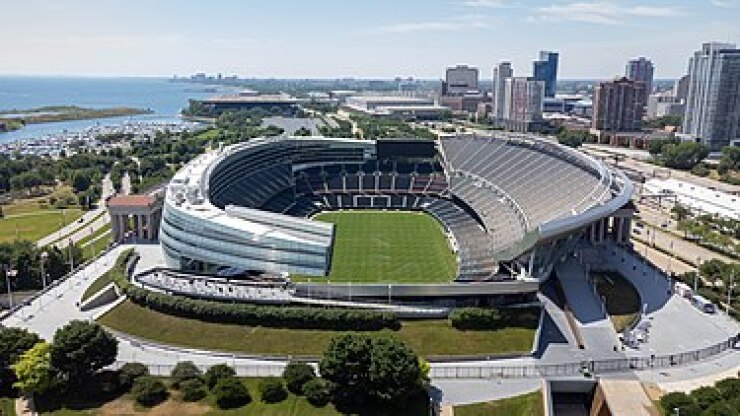The National Football League’s Chicago Bears are pursuing plans to build a publicly owned domed stadium in Chicago, boosted by $2 billion of private funds.
The team has changed course after chasing a planned stadium development in Arlington Heights, a northwest suburb of Chicago, where talks were bogged down amid disagreements with three area school districts over the Bears’ demands for property tax discounts.
“The Chicago Bears are proud to contribute over $2 billion to build a stadium and improve open spaces for all families, fans and the general public to enjoy in the City of Chicago,” the team said in a statement Monday. “The future stadium of the Chicago Bears will bring a transformative opportunity to our region — boosting the economy, creating jobs, facilitating mega events and generating millions in tax revenue. We look forward to sharing more information when our plans are finalized.”
Wikipedia
Chicago Mayor Brandon Johnson released a statement calling the Bears’ plans “a welcome step” and “a testament to Chicago’s economic vitality.”
“I have said all along that meaningful private investment and a strong emphasis on public benefit are my requirements for public-private partnerships in our city,” Johnson said. “I look forward to subsequent talks with the Bears, state leadership and community stakeholders about how we can continue to responsibly support the aspirations of the team, its fans and all residents of the City of Chicago.”
The city’s finance department declined to comment, pointing to the mayor’s statement. A Bears spokesman likewise referred all questions to their statement.
Previous administrations’ attempts to
The new planned stadium in the parking lot south of Soldier Field would come with 20% more open areas, including disabled persons-accessible public plazas, landscaping and public spaces on the lakefront,
There’s no word yet on total estimated cost or how much public money might ne needed, but the Illinois Sports Authority
This news comes on the heels of reports that Related, the developer building a new stadium for the Major League Baseball’s White Sox as part of a mixed-use South Loop development known as The 78, is seeking to form a financing partnership with the Bears,
A Related spokesman said the firm had no comment at this time.
Related Midwest President Curt Bailey told The Sun-Times that “we have spoken with” the Bears and “I am very optimistic on putting something together with that great franchise.”

Related
The financing for the new White Sox stadium would involve a 35- to 40-year extension of bonds issued by the Illinois Sports Facilities Authority, Bailey said, backed by a two percentage point hotel tax hike of the same type used to finance Soldier Field renovations.
Fitch Ratings
